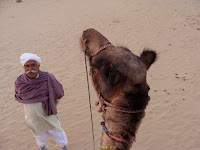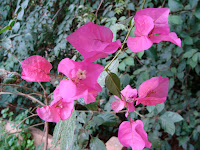I stayed at Manvar Desert Resort and Camp from December 12 - 14, 2009. It's located about a 90 minute drive from Jodhpur, on the road to Jaisalmer.For my first night I stayed in a tent at the camp. For most Canadians, the words "tent" and "camp" are synonymous with "roughing it." Manvar was the exact opposite.
My tent included a private three-piece bathroom with hot and cold running water, and to keep me warm during the cold desert nights, resort staff turned on an electric heater and put a hot water bottle in my bed. Some of my Canadian camping friends may wonder if I've now been spoiled for anything else. Relax! I love camping in Canada. However, I admit that the hot water bottle is a luxury that I may just permit myself the next time I'm in a tent.The camp is about 7 kilometres from the resort and highway; it was one of the most quiet and relaxing places I visited in all of India. The location has a mix of small farms and natural areas. Just outside the camp I saw my first peacock in the wild.In the early evening, people from the area entertained us with music and dancing, which I really enjoyed. Towards the end they invited us to join in the dancing too; sorry, there is no video of me.In the morning I went for a camel ride for a couple hours with my guide. I saw the sunrise over the desert.We were able to get really close to an eagle.The camel was very calm. He only seemed to assert himself when he wanted to stop for a bite to eat. Later that morning, I went for a ride in a jeep.We stopped to visit a few places. This is the local blacksmith. In front of his forge, you can see some axe heads, and a tray with smaller items like pipes, spoons and bells, which tourists such as me are more likely to purchase. The bicycle wheel in the background is used to power bellows for the forge.We also stopped at a farm. These small structures are for chickens. The building material is cow dung mixed with straw. In the arid desert, it is simple and cheap to make and maintain. Goats are also well-adapted to a desert environment. This young guy reminded me of when I was growing up on our farm, with goats of our own.Farmers also raise sheep.Some people keeps dogs too. They can help protect the livestock from foxes. And a litter of puppies is always entertaining.These are some of the different types of food grown in the area. The white cob-like vegetable is millet. I can't remember what the other ones are.We also saw many of these deer-like wild animals in the desert.I moved from the camp to the resort for the second part of my stay. The resort was very comfortable too, and although it was just off the highway, it was still fairly quiet.
Irrigation plays a big role in the lushness one sees here.
Bird life was abundant.
The cat kept a close eye on the comings and goings of the birds.


























































